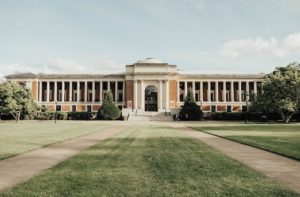What Our Master Planning Says About Us
August 3, 2012
Huffington Post
If great educational institutions are built through the perception created by the intersection of people, programs and facilities, it is a college’s physical plant that creates the first — and arguably — most lasting impression.
 Many students say that they make their final decision on which college or university to attend because “they know it when they feel it.”
Many students say that they make their final decision on which college or university to attend because “they know it when they feel it.”
If great educational institutions are built through the perception created by the intersection of people, programs and facilities, it is a college’s physical plant that creates the first — and arguably — most lasting impression. The buildings represent the visual statement of where the institution is and where it is headed. The physical plant is an expression of confidence, ego and ethos. It is a remarkable demonstration of institutional strength and failure, noble intentions, and significant planning mistakes. The physical plant is a primary admissions tool, a faculty and staff recruitment opportunity, and a statement of overall financial health.
To prospective students and their families, new construction is a symbol of potential; an investment into their future. Whereas the continued construction summer after summer creates fatigue for faculty. Ultimately, it comes down to how an institution incorporates these new builds into their master plan. The best master plans, create, support and nurture an environment. A building without context — measured by size and human scale, relationship to other buildings, institutional design principles, and landscape and site fit — is a failure at whatever cost. In the end, it is the principles that support a master plan that matter most. The differences are important. The design principles should be historic, organic and widely invested in by the college’s primary constituencies. In the best environments, the master plan never adjusts to or accommodates construction; rather, the building emerges from the master plan.
Buildings support the people and enhance the programs within them, thus should meet the needs, anticipate the growth, and be developed with an eye to long-term expansion. Great master plans go beyond the physical aspect to support strategic plans. They separate what is needed from what is wanted, sharpen the institutions priorities, and shape donor requests. This puts the respective facilities into competition with people and programs for support. By incorporating the out of classroom experience – housing, social and cultural needs – master plans can shape and refine institutional ethos. They determine whether and where campus social life is centered. The results can have dramatic effects on retention and graduation rates, alumni support, and college ranking perceptions.
In the end, the best advice may be to avoid building until you create the foundation upon which sustainable construction should be based — the campus master plan…Build for the future by linking history to long-term needs. Use master planning to reinforce the institutional ethos and sense of self. Proceed with confidence, clarity and anticipate how an institution’s strategic plan will change the dynamics and look of a college in twenty years. Use the master plan as an agent of change but the change prescribed should be organic, systemic and relevant to where an institution is headed. When the alumni return to claim that the “place feels the same” despite all of the changes, they have provided their alma mater with that most important metric for success — you know it when you feel it.
To read the full article, you may view it here on Huffington Post.
